Chapter 1
INTRODUCTION TO DISCRETE EVENT
SIMULATION
This introductory chapter is concerned with the concept of
time advance simulation and to set it into the context of the analysis of real world
systems. The paradigms of Discrete Event Simulation (DES) are then introduced
through the example of a single server queue. Event lists are then introduced through the
medium of manual simulation.
1.1 Introduction
A dictionary definition of the verb simulate might be
some form of words like: to mimic, to take the form of something. In this
context it is often used to mean a form of deceit. However in mathematical modelling
we use the word to represent the numerical time advance modelling of some real world
system.
Computer
simulation is a powerful tool that is often applied to the design and analysis of complex
systems. Decisions can be made about the system by constructing computer models of it
and conducting experiments on the model.
1.2 What is the Purpose of Simulation ?
There are a
number of reasons why it may be preferable to carry out experiments on a model rather
than directly on the real system:
- The results of the experiment may be unpredictable or dangerous to the system or
the personnel operating it.
- Experiments may unacceptably disrupt the operational requirements of the system.
- A new system may require design decisions to be made prior to construction of the
system.
- A simulation experiment may be precisely repeated any number of times. In many
instances a real dynamic system would not allow precise replication.
- Confidentiality is easier to maintain with a computer simulation where only a few
key people would be privy to the results. The results of experimenting with a real
system are more open.
- Time scale of the real system may be too long (e.g. evolution of a galaxy), or too
short (e.g. impact between vehicles) for convenient experimentation.
- Training.
1.3 Simulation Models
A simulation
project involves building a model of the system to be studied. In order to do this we
must clearly understand what we mean by a model. Models, for our purpose, fall into
three categories:
- Iconic & physical models
. These are
physical models usually at a reduced scale. Examples are wooden models of cars or
an aircraft wing and the model describes the shape of the object that is being modelled.
The purpose of such models is often to investigate the relationship between the shape of
the object and the environment in which it will operate. For example, wind tunnel
testing.
- Abstract models. These are
mathematical equations. Examples are the equations describing physical laws of nature
and scientific laws. These models often describe motion or forces that exist between
objects. The purpose of such models is often to investigate what impact there will be
on the system as a whole if changes are made to individual elements of the
system.
- Visual models. These are graphical
representations. Examples are schematic diagrams of electronic equipment or flow
charts that describe the logic of a computer program. The purpose of these models is
usually to enable the operating rules and processes of a system to be
understood.
Note the recurrence of the words 'describes' and 'purpose' in
this list. A model is a description and the form that the model takes is very dependent
on the purpose of the model. The purpose of a model is, therefore, an important aspect
of model formulation and must be discussed and agreed before a model of the system
can be constructed. The purpose may be expressed in the form of statements concerning
what decisions are expected to be made as a result of the simulation study. The model
is then constructed in a form that will enable the correct decision to be made.
For example, a
company may be wishing to expand production of a particular product. To do this they
will need to purchase one or more additional machines. There is a choice between a
high throughput, high cost machine or a low throughput, low cost machine. The purpose
of the simulation may be to ascertain the number of machines of each type that would be
needed to achieve target production.
Example 1.1
A Flight Simulator
is an example of simulation that comes readily to mind. It is used to train novice pilots
to fly modern jet aircraft realistically but without the danger to life that could occur
flying a real aircraft. Flight simulators also allow experienced pilots to gain
experience with unfamiliar aircraft. A flight simulator consists of an exact replica of an
aircraft cockpit with all of the controls and meters but without the fuselage, wings,
engines or (and perhaps most importantly!) passengers.
The student pilot uses exactly the same controls and sees the
same instruments that would be in a real aircraft of that type. However, the outputs
from the controls are passed to a computer rather than to the flaps, engines,
undercarriage etc. of a real aircraft. The pilot is given the same sort of feedback that
would be experienced flying a real aircraft and the instruments would show readings
that reflect a real flight. When the computer senses that a pilot has used a control that
would make the nose of the aircraft lift then the computer sends signals to motors that
lift the nose of the flight simulator. Similarly it can be made to bank to the left and
right; engine noise is made to increase and decrease appropriately; and the view from
the cockpit changes in response to changes in direction and inclination. Thus the pilot's
senses of touch, sight, hearing and physical orientation receive the same sort of stimuli
that they would receive flying a real aircraft. The big difference, however, is that if the
pilot 'crashes' the simulator nothing is dented (except perhaps the pilot's pride!).
This is one, obvious, benefit of using a simulator instead of a
real aircraft for training purposes but there are others, including:
- immediate access to a specific part of the training
programme. If you want to practice landing, the simulator doesn't have to take-off first -
- the real aircraft does
- changeover time between students is low. A real aircraft
would have to be refuelled and perhaps inspected
- fault situations (random or specific) can be programmed
into a training session to test the pilots ability to react correctly and in
time.
There is a high degree of correspondence, from the pilot's
viewpoint, between flying a simulator and flying a real aircraft. And this is exactly the
purpose of the flight simulator.
In other situations such a high level of realism is both
unnecessary and undesirable. The simulation model should contain sufficient detail for
the functionality of the system to be understood but excluding unnecessary complexity
that clouds understanding.
1.4 DES simulation paradigms
A major subclass
of simulation problems is concerned with the simulation of time varying systems which
are controlled by a combination of either physical, chemical, biological or man made
laws. Such systems can be categorised by the way in which time is treated in the
simulation. The variation in time may be considered continuous in some systems whilst
in others the state of the system changes at discrete time intervals. This phenomenon
gives rise to two branches of simulation: Discrete Event Simulation and Continuous
Simulation. Clearly, models of such systems must also be capable of changing their
state in a similar manner.
Continuous
simulation problems are essentially based on the solution of time dependent partial
differential equations. If the simulation is computer based only finite steps can be
incorporated and, hence, small equal time increments are employed to approximate to
the real world situation. Typical applications include:
- Development of eco-systems
- Economic forecasting systems
- Thermal balance in nuclear reactors
- Evolution of stellar systems
Discrete simulation examines problems in which the ordering
and timing of events is the main focus of interest. In such systems the interest is on on
the time at which some activity commences or ceases. For example, in simulating a
computer network to estimate the effective system capacity or queue sizes, we may be
interested in the start time and duration of job processing rather than details of the
signal transmission on the network. In such problems it is not efficient to advance time
in small fixed steps but to advance to the time of the next event. Since, in general,
events can occur at any time, the time advance is non-uniform and can be alternately
large or small. Typical applications include:
- Factory layout and process planning.
- Transport systems.
- Telecommunications networks.
- Office management systems.
Discrete simulation can be further subdivided in terms of the
methodology followed. Figure 1 shows the general scheme.
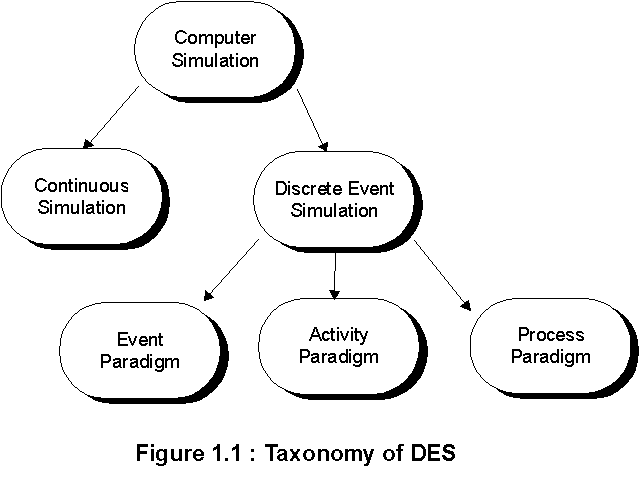
Event
| The events and their consequences that influence the
progress of the simulation are listed and the simulation is progressed by working
through a time based 'event list'.
|
Activity
| For each entry (product, resource etc.) that is
involved in the simulation a cycle of activities is drawn up. All entity cycles are then
merged into a single activity diagram which forms the basis of the model.
|
| Process | The processes through which the 'key' entities
pass is listed as a sequence which forms the basis of the model. The key entities are
usually the product being studied and other entities become resources used by the key
entities.
|
The three types are
not exclusive and, in general, a study can be formulated in any of the paradigms. Mixed
paradigm representations are also possible.
We can make the distinction between the paradigms clearer by
using a very simple example, the single server queue, and partially developing the
model in the three paradigms.
Consider a small branch of a bank which has a single counter
with one clerk available throughout the day to serve customers. Customers arrive and if
no other customer is in the bank they receive service, otherwise they wait in a
queue.
Example 1.2 The Event Paradigm
The model development process begins with listing the
important events which occur in the real system. As a guide an important event is one
which changes the state of the system (e.g. changes the activity of the clerk or the length
of the queue.)
In this simple example there are clearly two important events :
Customer arrival & Customer departure.
The next task is to quantify precisely the results throughout the
system of the events. In this instance we can achieve this by using the IF - THEN -
ELSE formalism.
Customer Arrival :
IF (Clerk = idle) THEN Clerk = busy
ELSE Queue = Queue + 1
Customer Departure :
IF (Queue > 0) THEN Queue = Queue - 1
ELSE Clerk = idle
Notice that the condition of a 'state variable' is used to decide
the action or actions to be taken when the event occurs. A state variable is a parameter
which defines the status of the system being simulated. Thus the Clerk's status (idle or
busy) is a binary state variable and the length of the queue is an integer state
variable.
How to proceed to with the simulation will be discussed in
section XX following the definition of the problem in the other two paradigms.
Example 1.3 The Activity Paradigm
The first task is to identify all the key entities which will play
a part in the simulation. In this case this is clearly the 'Clerk' and the 'Customer'.
Notice if the simulation model had a different emphasis other entities may play a part
(for example available queuing space or cash in bank etc.)
Having identified the entities the next task is to describe for
each a complete, closed cycle of activity. A 'cycle of activity' consists of an alternating
sequence of the form : ACTIVITY - QUEUE - ACTIVITY - QUEUE ……
For the Clerk this is very simple :
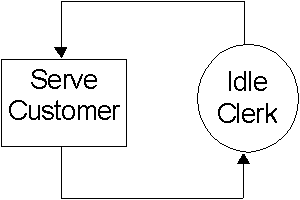
For the customer the cycle is a little more involved because
we must arrange for her to appear in the bank and depart from the bank after receiving
service. We achieve this by invoking a very general queue known as the 'World Queue'
and a special arrival activity.

Notice that the customer may pass straight through the 'Wait
Service' queue if the Clerk is available to serve him. The arrival activity is rather
special as indicated by the sub loop on the symbol. This topic will be taken up further
in chapter 3.
All the individual entity cycles are now combined to form a
single activity cycle diagram for the model. This is achieved by looking for
corresponding activities in the different cycles. In this example the activities 'Receive
Service' and 'Serve Customer' are clearly the only common activity. We can now draw
the complete Activity Cycle Diagram (ACD).

An activity can only take place if the required quantity of
entities is available in each preceding queue. In this example the activity 'Service can
only take place if a Clerk is available in the 'Idle Clerk' queue and a Customer in the
'Wait Service' queue.
Example 1.4 The Process Paradigm
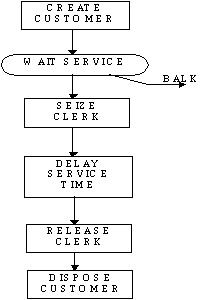 The entities again form the focus of the method but they are divided into two classes :
Entities proper which move through the model and resources which may be seized and used
by the primary entities. In the bank example we can construct the model using the
Customer as a primary entity and the Clerk as a resource. Customers are created according
to some known arrival distribution and move immediately to the Wait Service queue.
Here they will be held until the Clerk is freed by the preceding customer when they,
in their turn can seize the Clerk. The 'BALK' is a facility for disposing of customers
from the queue when the queue capacity is exceeded. After delaying by their service
time the customers release the Clerk to make the Clerk available to any following
customers. The Customer entity is finally disposed of.
The Process Paradigm is the most intuitive and the one most used by the simulation
software available on the market. However the Activity Paradigm has the distinct
advantage of providing a completely logical description of the model.
The entities again form the focus of the method but they are divided into two classes :
Entities proper which move through the model and resources which may be seized and used
by the primary entities. In the bank example we can construct the model using the
Customer as a primary entity and the Clerk as a resource. Customers are created according
to some known arrival distribution and move immediately to the Wait Service queue.
Here they will be held until the Clerk is freed by the preceding customer when they,
in their turn can seize the Clerk. The 'BALK' is a facility for disposing of customers
from the queue when the queue capacity is exceeded. After delaying by their service
time the customers release the Clerk to make the Clerk available to any following
customers. The Customer entity is finally disposed of.
The Process Paradigm is the most intuitive and the one most used by the simulation
software available on the market. However the Activity Paradigm has the distinct
advantage of providing a completely logical description of the model.
1.5 Maintaining Event Lists
At the heart of Discrete Event Simulation is the concept of an
event and the time at which that event occurs. At the outset of the simulation the time at
which events will occur (or even the fact that they will occur at all) is unknown apart
from the first one or two events. If this were not true there would be no point in carrying
out a simulation experiment because all events would be known. This becomes clear
when you remember that if the arrival processes and activity times are stochastic then
the time spent in a queue by an entity cannot be determined in advance. To progress a
simulation through time it is necessary to maintain an ordered list of events and the time
at which they are to occur. New events are added to the list as they become known and
the current event pointer advances to the next event time on the list. Fig. 1.2 illustrates
the idea where successively defined events are labelled E1,
E2, E3,…. Etc.
Suppose at time T1 the event
E5 is about to be processed and that processing E5 will
generate two new events E9 and E10 at times
T2 and T3. Fig. 1.2 shows the event list before and
after processing E5
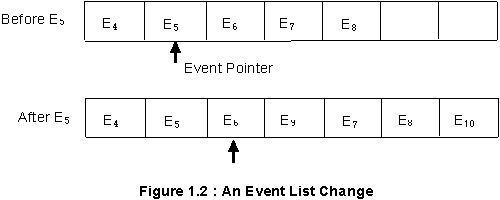
Notice that E9 will occur between E6 and E7 and has been
ordered by time of occurrence E10 is presumed to take place after any of the existing
events. Once we have established the event list we can process the simulation by a
repetition of the following three steps until the simulation is complete :
Start Phase
Start all activities (process all start events) possible at the
current simulation time and log any future events that can now be defined. Record any
parameters that you wish to keep as the simulation progresses (e.g. the length of
queues).
Time Phase
Advance time to the time of occurrence of the next event in the
event list.
End Phase
Stop any activities (process all end events) possible at the
current simulation time and move entities onto their next queue.
It is, of course, the job of the simulation language to maintain
the event list. to start and stop processes at the appropriate time and record all required
statistics. This is a major advantage of using a simulation language over a 3GL for
simulation however it is very useful to ensure that you understand the mechanics of the
process by trying one or two simulations by hand
Example 1.5 Simulating the Bank Clerk problem
The first 10 customers arriving at the bank have their arrival
time and service time recorded. Table 1.1 shows the results. Notice immediately that
predicting future events by inspection of the table is impossible. For example at what
time will the 5th customer leave the bank ?
Table 1.1 : Customer data
|
Customer
No |
Time of Arrival
(mins) |
Service Time
(mins) |
1
2
3
4
5
6
7
8
9
10 |
3.2
10.9
13.2
14.8
17.7
19.8
21.5
26.3
32.1
36.6 |
3.8
3.5
4.2
3.1
2.4
4.3
2.7
2.1
2.5
3.4 |
Let us use this data to answer the following questions by an
event driven hand simulation:
- What % of time is the clerk idle ?
- What is the average time a customer spends in the bank ?
- What is the maximum queue size ?
|
The initial conditions are :
| no customers in bank
clerk idle
first arrival at time 3.2
|
We start the simulation by drawing up the following event
table to record the data and enter the starting conditions.
|
Event
Time |
Event
Type |
Queue
Size |
Clerk
Status |
Idle
Time |
|
0 |
- |
0 |
I |
- |
|
3.2 |
A |
0 |
B |
3.2 |
As soon as we carry out the arrival event at time 3.2 we can
predict a departure event for customer 1 at time 3.2 + 3.8 = 7.0 mins. Since the next
arrival event is at time 10.9 we know that this departure event will be event number 2
followed by event 3, the arrival of the second customer. Our table now looks like the
following :
|
Event
Time |
Event
Type |
Queue
Size |
Clerk
Status |
Idle
Time |
|
0 |
- |
0 |
I |
- |
|
3.2 |
A |
0 |
B |
3.2 |
|
7.0 |
D |
0 |
I |
- |
|
10.9 |
A |
0 |
B |
3.9 |
Notice we can record an idle time figure for the Clerk each
time his status changes from idle to busy. After another event our table looks like the
following :
|
Event
Time |
Event
Type |
Queue
Size |
Clerk
Status |
Idle
Time |
|
0 |
- |
0 |
I |
- |
|
3.2 |
A |
0 |
B |
3.2 |
|
7.0 |
D |
0 |
I |
- |
|
10.9 |
A |
0 |
B |
3.9 |
|
13.2 |
A |
1 |
B |
- |
You should aim to complete
this example by processing all ten customers to answer the problem set.
n
Let us now try an example using the event list in conjunction
with the Activity Cycle Paradigm. To follow this example and complete the problem
you may find it useful to draw out the ACD on a large sheet of paper and move counters
(e.g. small coins) to represent jobs flowing through the system.
Example 1.6 Production Scheduling
A small manufacturing company uses three machines M1, M2
and M3 in its production process. Three products A,B and C are manufactured and each
product moves through the machines in the same order M1 - M2 - M3. The process
time in hours for each product on each machine is given by the following table
| |
A |
B |
C |
|
M1 |
8 |
3 |
2 |
|
M2 |
2 |
9 |
7 |
|
M3 |
3 |
5 |
6 |
Today the company will manufacture 2 A products, 2 B
products and 1 C product. The production manager has decided to manufacture them in
the sequence AABBC and needs to know :
- The queue size before each machine
- The utilisation of each machine
- The total production time
It is easy to see that the ACD for this problem is the following
:
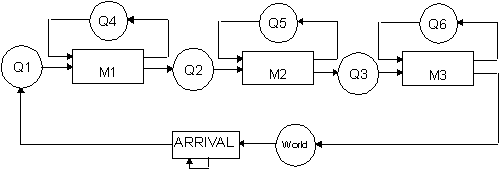
Q1,Q2 and Q3 are the work queues prior to each machine and
Q4, Q5 and Q6 are the idle machine queues. We will assume that the arrival activity is
defined to allow all jobs to reside in Q1 at time 0.
Start phase : At time 0 we can start the first A product on M1.
This allows us to define an end event at time 8 hours when the first A product will
finish processing on M1. No other activities can start at time 0
Time phase : Advance time to the next event which is T = 8
when the first A product completes its processing on M1.
End phase : Stop the processing of the A product on M1 and
move it to its next queue (Q2). No other activity can end at this time.
Start phase: Start the second A product on M1 and log an end
event at time T = 16. Start the first A product on M2 and log an end event at time T =
10. Record the length of the three machine queues.
Time phase: Advance time to the next event (T=10)
The following table reflects the situation at this stage :
|
T |
M1 |
M2 |
M3 |
Q1 |
Q2 |
Q3 |
|
0 |
A |
I |
I |
4 |
0 |
0 |
|
8 |
A |
A |
I |
3 |
0 |
0 |
|
10 |
A |
I (2) |
A |
3 |
0 |
0 |
When a machine switches from active to idle the active time
elapsed since the last period of idleness is recorded and indicated in parenthesise. This
enables us to calculate the utilisation of each machine from the definition :

Where Ta is the active time and
TS the total simulation time.
You should complete this simulation
 The entities again form the focus of the method but they are divided into two classes :
Entities proper which move through the model and resources which may be seized and used
by the primary entities. In the bank example we can construct the model using the
Customer as a primary entity and the Clerk as a resource. Customers are created according
to some known arrival distribution and move immediately to the Wait Service queue.
Here they will be held until the Clerk is freed by the preceding customer when they,
in their turn can seize the Clerk. The 'BALK' is a facility for disposing of customers
from the queue when the queue capacity is exceeded. After delaying by their service
time the customers release the Clerk to make the Clerk available to any following
customers. The Customer entity is finally disposed of.
The Process Paradigm is the most intuitive and the one most used by the simulation
software available on the market. However the Activity Paradigm has the distinct
advantage of providing a completely logical description of the model.
The entities again form the focus of the method but they are divided into two classes :
Entities proper which move through the model and resources which may be seized and used
by the primary entities. In the bank example we can construct the model using the
Customer as a primary entity and the Clerk as a resource. Customers are created according
to some known arrival distribution and move immediately to the Wait Service queue.
Here they will be held until the Clerk is freed by the preceding customer when they,
in their turn can seize the Clerk. The 'BALK' is a facility for disposing of customers
from the queue when the queue capacity is exceeded. After delaying by their service
time the customers release the Clerk to make the Clerk available to any following
customers. The Customer entity is finally disposed of.
The Process Paradigm is the most intuitive and the one most used by the simulation
software available on the market. However the Activity Paradigm has the distinct
advantage of providing a completely logical description of the model.






